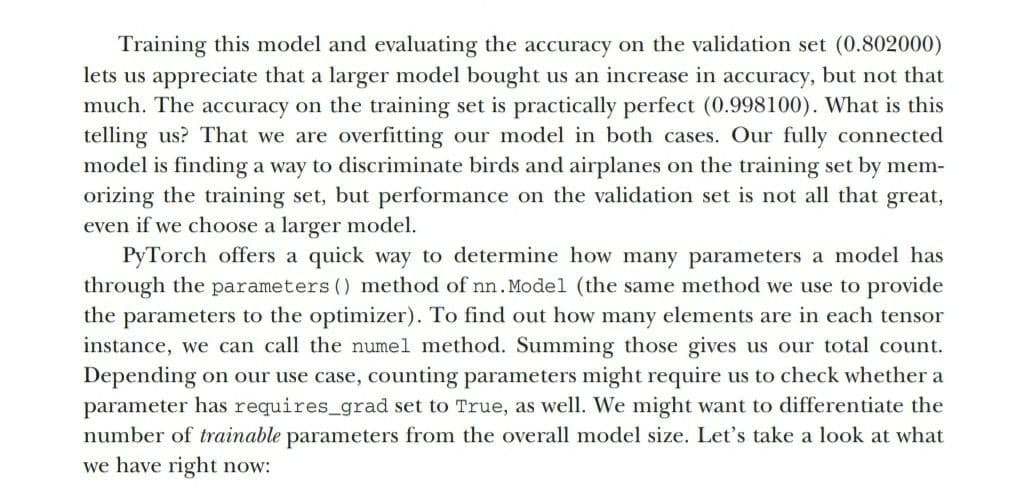Training this model and evaluating the accuracy on the validation set (0.802000) lets us appreciate that a larger model bought us an increase in accuracy, but not that much. The accuracy on the training set is practically perfect (0.998100). What is this telling us? That we are overfitting our model in both cases. Our fully connected model is finding a way to discriminate birds and airplanes on the training set by mem- orizing the training set, but performance on the validation set is not all that great, even if we choose a larger model. PyTorch offers a quick way to determine how many parameters a model has through the parameters () method of nn. Model (the same method we use to provide the parameters to the optimizer). To find out how many elements are in each tensor instance, we can call the numel method. Summing those gives us our total count. Depending on our use case, counting parameters might require us to check whether a parameter has requires_grad set to True, as well. We might want to differentiate the number of trainable parameters from the overall model size. Let's take a look at what we have right now:
Training this model and evaluating the accuracy on the validation set (0.802000) lets us appreciate that a larger model bought us an increase in accuracy, but not that much. The accuracy on the training set is practically perfect (0.998100). What is this telling us? That we are overfitting our model in both cases. Our fully connected model is finding a way to discriminate birds and airplanes on the training set by mem- orizing the training set, but performance on the validation set is not all that great, even if we choose a larger model. PyTorch offers a quick way to determine how many parameters a model has through the parameters () method of nn. Model (the same method we use to provide the parameters to the optimizer). To find out how many elements are in each tensor instance, we can call the numel method. Summing those gives us our total count. Depending on our use case, counting parameters might require us to check whether a parameter has requires_grad set to True, as well. We might want to differentiate the number of trainable parameters from the overall model size. Let's take a look at what we have right now:
Computer Networking: A Top-Down Approach (7th Edition)
7th Edition
ISBN:9780133594140
Author:James Kurose, Keith Ross
Publisher:James Kurose, Keith Ross
Chapter1: Computer Networks And The Internet
Section: Chapter Questions
Problem R1RQ: What is the difference between a host and an end system? List several different types of end...
Related questions
Question
Hello help Data science

Transcribed Image Text:Training this model and evaluating the accuracy on the validation set (0.802000)
lets us appreciate that a larger model bought us an increase in accuracy, but not that
much. The accuracy on the training set is practically perfect (0.998100). What is this
telling us? That we are overfitting our model in both cases. Our fully connected
model is finding a way to discriminate birds and airplanes on the training set by mem-
orizing the training set, but performance on the validation set is not all that great,
even if we choose a larger model.
PyTorch offers a quick way to determine how many parameters a model has
through the parameters () method of nn. Model (the same method we use to provide
the parameters to the optimizer). To find out how many elements are in each tensor
instance, we can call the numel method. Summing those gives us our total count.
Depending on our use case, counting parameters might require us to check whether a
parameter has requires_grad set to True, as well. We might want to differentiate the
number of trainable parameters from the overall model size. Let's take a look at what
we have right now:
Expert Solution
This question has been solved!
Explore an expertly crafted, step-by-step solution for a thorough understanding of key concepts.
Step by step
Solved in 2 steps with 1 images

Recommended textbooks for you

Computer Networking: A Top-Down Approach (7th Edi…
Computer Engineering
ISBN:
9780133594140
Author:
James Kurose, Keith Ross
Publisher:
PEARSON

Computer Organization and Design MIPS Edition, Fi…
Computer Engineering
ISBN:
9780124077263
Author:
David A. Patterson, John L. Hennessy
Publisher:
Elsevier Science

Network+ Guide to Networks (MindTap Course List)
Computer Engineering
ISBN:
9781337569330
Author:
Jill West, Tamara Dean, Jean Andrews
Publisher:
Cengage Learning

Computer Networking: A Top-Down Approach (7th Edi…
Computer Engineering
ISBN:
9780133594140
Author:
James Kurose, Keith Ross
Publisher:
PEARSON

Computer Organization and Design MIPS Edition, Fi…
Computer Engineering
ISBN:
9780124077263
Author:
David A. Patterson, John L. Hennessy
Publisher:
Elsevier Science

Network+ Guide to Networks (MindTap Course List)
Computer Engineering
ISBN:
9781337569330
Author:
Jill West, Tamara Dean, Jean Andrews
Publisher:
Cengage Learning

Concepts of Database Management
Computer Engineering
ISBN:
9781337093422
Author:
Joy L. Starks, Philip J. Pratt, Mary Z. Last
Publisher:
Cengage Learning

Prelude to Programming
Computer Engineering
ISBN:
9780133750423
Author:
VENIT, Stewart
Publisher:
Pearson Education

Sc Business Data Communications and Networking, T…
Computer Engineering
ISBN:
9781119368830
Author:
FITZGERALD
Publisher:
WILEY